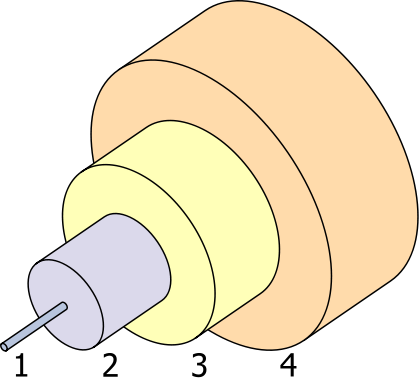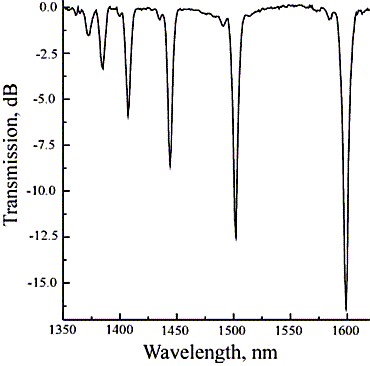I started something about LPG fibers here
http://hackaday.io/project/1379/log/3243-how-do-fiber-optic-sensors-work but I still get questions about the topic, so I decided to insert another log about the principles behind the LPG fiber optic sensors (LPG FOS).
Single mode optical fiber consists of four main parts:
 1: Optical core (outer diameter 9um), carrying the useful information.
1: Optical core (outer diameter 9um), carrying the useful information.
2: Cladding (outer diameter 125um). It has different refraction index compared to core, helps to keep the light inside the core.
3: Buffer: first line of mechanical protection (outer diameter cca 0,25mm), it has nothing to do with light.
4: Jacket: outer mechanical protection with various thickness (outer diameter 0,6 to few mm).
In normal conditions, there are no active cladding light modes (= no light propagates throught cladding), only one core mode (= light propagates through core, however different refraction index of cladding keeps the core mode inside the core) and optical fiber is transparent as expected, assuming normal telecommunication range of 1500-1600nm (near infrared light). However, under special conditions, like microbend or damaged fiber (in my case - slight "destruction" of fiber structure with high temperature of electric arc), part of the light escapes into cladding. Nothing special happens, unless the perturbation is periodic - at the perturbation points the core and cladding modes are mixed (part of cladding mode gets into core and vice versa). Because speed of light in cladding is slightly different compared to core (due to different refration index), the mixed modes are out of phase, phase cancellation for some wavelengths is observed.
 This effect increases insertion loss (=the fiber is less "opaque" for some wavelengths) at specific wavelengths. Spectral characteristics of the fiber looks like this
This effect increases insertion loss (=the fiber is less "opaque" for some wavelengths) at specific wavelengths. Spectral characteristics of the fiber looks like this
 If we concentrate on particual section of the spectrum, like 1480-1550nm, there is only one peak. Because the phase cancellation conditions depend on physical dimensions between perturbations (grating period), change of the grating period changes also the peak wavelength. Grating period can be changed by stressing the fiber (normal glass fiber can be elongated up to few percents with its elastic, reversible deformation), so applying mechanical strain on the fiber with LPG also changes peak wavelength accordingly (to higher wavelentgths). After releasing the strain, mechanical properties of fiber retrun to normal and peak wavelength. Reversing the observation: from the change of wavelength we can determine strain applied to sensor and this is what looks like tensometer - it actually IS tensometer! ;-)
If we concentrate on particual section of the spectrum, like 1480-1550nm, there is only one peak. Because the phase cancellation conditions depend on physical dimensions between perturbations (grating period), change of the grating period changes also the peak wavelength. Grating period can be changed by stressing the fiber (normal glass fiber can be elongated up to few percents with its elastic, reversible deformation), so applying mechanical strain on the fiber with LPG also changes peak wavelength accordingly (to higher wavelentgths). After releasing the strain, mechanical properties of fiber retrun to normal and peak wavelength. Reversing the observation: from the change of wavelength we can determine strain applied to sensor and this is what looks like tensometer - it actually IS tensometer! ;-)
Now you can ask, what is the point of all the effort put into this kind of sensor? Electrical tensometers exists and work for decades and there is little reason for use anything else, you may think. Partially, you are right, however measuring signals from tensometers is getting tough (due to its low signal levels) if you wish to connect it through long cable or in electrically noisy environment. The main advantafe of fiber optic sensors is that there is actually no electric signal at the measured region (the spectromter has to be electric, of course), so it is inherently imunne to electromagnetic interference or even ionizing radiation. What more, no electricity at the place means absolute safety for critical environments, like combustive gasses or for biological experiments. There is no problem running few kilometers (!) of fiber to sensor with no negative influence on measurement precision or speed.
One can inscribe more than one LPG (with different peak wavelengths) into various places of signle fiber, creating multi-point sensing system withing single thin (250um) optical fiber.
All those features makes fiber optic sensors the sensors of future. It is already used in high-end civil engineering projects and massively in aerospace and military field, however for normal mainstream use it is too exotic and expensive; hopefully this will change a bit with this project.
 jaromir.sukuba
jaromir.sukuba
Discussions
Become a Hackaday.io Member
Create an account to leave a comment. Already have an account? Log In.